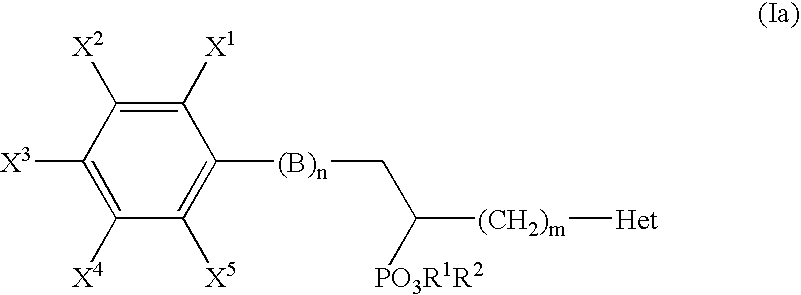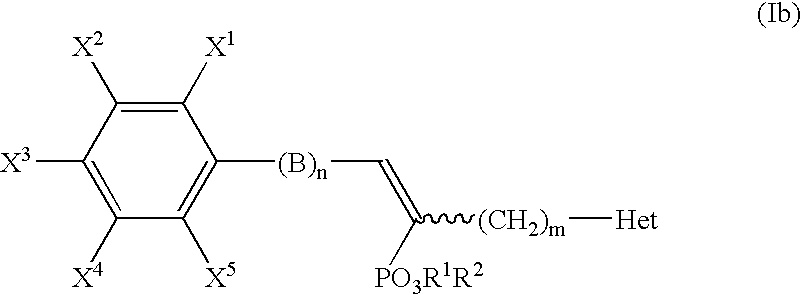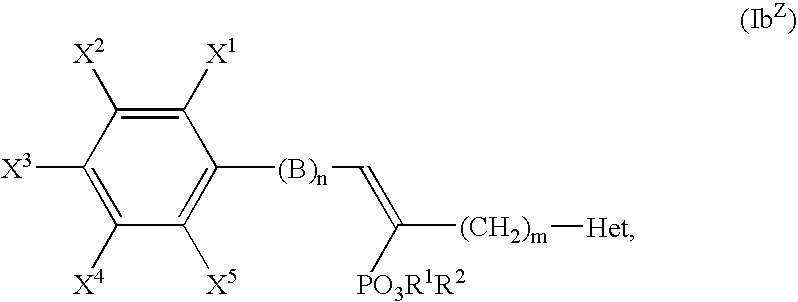Alpha-substituted heteroarylalkyl phosphonate derivatives
- Summary
- Abstract
- Description
- Claims
- Application Information
AI Technical Summary
Benefits of technology
Problems solved by technology
Method used
Image
Examples
example 1
(E)-Diethyl β-(4-hydroxy-3-methoxy-5-methylphenyl)-α-(3-pyridyl)-vinyl Phosphonate
[0067]
[0068] 60% NaH (8.63 g, 216 mmol) was washed three times with hexane and was suspended in 60 ml THF. This suspension was cooled to 0° and diethyl phosphite (27.8 ml, 216 mmol) was added dropwise. 30 Minutes after the end of the addition a solution of 3-chloromethylpyridine (13.8 g, 108 mmol) in 60 ml THF was added dropwise and the ice bath was removed. H2O (40 ml) was added dropwise after stirring at room temperature for 4 h, then sat. NH4Cl solution (40 ml) was added in one portion. The aqueous phase was separated and extracted with CHCl3 (3 portions of 200 ml). The combined organic layers were dried with MgSO4 and evaporated to give 25.8 g of a brown oil. Purification of this crude product by column chromatography (CHCl3 / MeOH 9 / 1) yielded 20.5 g (89 mmol, 82%) of a brown oil; GC-analysis indicated a purity of 97%.
[0069] The whole procedure was carried out at −78° C. and under a nitrogen atmos...
example 2
Diethyl β-(4-hydroxy-3-methoxy-5-methylphenyl)-α-(3-pyridyl)-ethylphosphonate
[0072]
[0073] A solution of (E)-diethyl β-(4-hydroxy-3-methoxy-5-methylphenyl)-α-(3-pyridyl)vinylphosphonate (18 g, 47.7 mmol) in 400 ml ethanol was hydrogenated over 9 g of 10% Pd / C catalyst in a Parr hydrogenation apparatus at an initial pressure of 50 psi. When hydrogen uptake has ceased, the catalyst was filtered off, the solvent was evaporated to give 17 g of slightly yellow solid. Purification of this crude product by recrystallisation from a mixture of ligroine and CH2Cl2 yielded 13 g (34 mmol, 72%) of a white solid, mp=85-87° C. GC-analysis indicated a purity of 100%.
[0074] MS (m / e)=379: M+, 241 (100%): M+—HPO3Et2 NMR (CDCl3): δ=8.45, 8.38, 7.70 and 7.22 (4m, 1H each): aromatic H, 3-pyridyl 6.39 and 6.21 (2d, 1H each, J=1.5 Hz): aromatic H, substituted phenyl 5.30 (s, 1H): OH 4.11-3.82 (3m, 4H total): P—O—CH2—CH3 3.67 (s, 3H): Ph-OCH3 3.44-3.36 (m, H): Ph-CH2—CH(P)-pyridine 3.3-3.2 and 3.07-2.97 (2...
example 3
(E)-Diethyl β-(4-hydroxy-3-methoxy-5-methylphenyl)-α-(5-(2-methylpyridyl))-vinylphosphonate
[0075]
[0076] 5-Chloromethyl-2-methylpyridine hydrochloride (15 g, 87.3 mmol) was suspended in 100 ml CH2Cl2 and a 10% NaOH solution was added while stirring until the pH of the aqueous phase was 8. The mixture was shaken then the CH2Cl2 phase was separated, dried over MgSO4 and evaporated to yield 11.9 g (100%) of the free base. 60% NaH (10.63 g, 440 mmol) was washed three times with hexane and was suspended in 100 ml THF. This suspension was cooled to 0° and diethyl phosphite (38.3 ml, 280 mmol) was added dropwise. 30 Minutes after the end of the addition a solution of 5-chloromethyl-2-methylpyridine (17.9 g, 120 mmol) in 10 ml THF was added dropwise and the ice bath was removed. The reaction was stirred for 4 h at room temperature then H2O (100 ml) was added dropwise, then sat. NH4Cl solution (100 ml) was added in one portion. The aqueous phase was separated and extracted with CHCl3 (3 port...
PUM
| Property | Measurement | Unit |
|---|---|---|
| Composition | aaaaa | aaaaa |
| Density | aaaaa | aaaaa |
Abstract
Description
Claims
Application Information
 Login to View More
Login to View More - R&D
- Intellectual Property
- Life Sciences
- Materials
- Tech Scout
- Unparalleled Data Quality
- Higher Quality Content
- 60% Fewer Hallucinations
Browse by: Latest US Patents, China's latest patents, Technical Efficacy Thesaurus, Application Domain, Technology Topic, Popular Technical Reports.
© 2025 PatSnap. All rights reserved.Legal|Privacy policy|Modern Slavery Act Transparency Statement|Sitemap|About US| Contact US: help@patsnap.com



